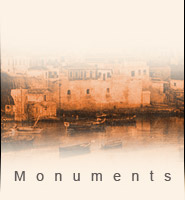The Venetian fountains and Ottoman drinking fountains which now adorn the city of Heraklion as monuments were originally constructed under Venetian and Ottoman rule for purely utilitarian reasons. Quite apart from being essential to daily life, water played a key role in Ottoman religious practices.
The city of Chandax suffered from water shortages so frequently that ensuring a supply from nearby springs was a major concern. Particularly under Ottoman rule, the construction of public drinking fountains was regarded as an act of philanthropy. At the same time, ornate kiosks distributing water free to passers-by were built on the city's thoroughfares.
Regardless of their raison d'être, both Venetian and Ottoman fountains are adorned with features representative of the time at which they were built, while symbolising the power of those who saw to their construction and the solicitude they showed towards the town.

A charitable drinking fountain (sebil) on the northeast side of the Armeria, 1900 - 1905 (G. Gerola, Heraklion)
The Numan Pasha charitable drinking fountain (sebil) which once stood opposite the Loggia, 1900 (Liana Starida Collection)
The Ibrahim Baba drinking fountain (Historical Museum of Crete, © S.C.H.S, Heraklion)














